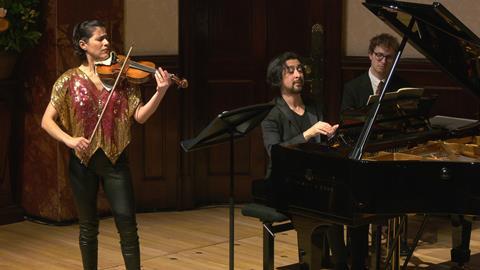The Violin Sonata by French composer Mel Bonis was a revelation for the US-born violinist, revealing both a new sound world and innovative techniques in music writing

Discover more Featured Stories like this in The Strad Playing Hub
Read more premium content for subscribers here
The 1914 Violin Sonata by Mel Bonis (1858–1937) is one of the hidden gems of the violin and piano repertoire. It’s an intoxicating work, full of sumptuous waves of emotion and romance. Audiences seem to respond to it in a visceral way, and it’s written beautifully for the violin: there are some tricky technical odds and ends, but it allows you to soar, fly and whisper with the instrument. It’s a physically as well as emotionally satisfying piece to play – perhaps especially so for me as I’ve learnt it alongside my husband, pianist Tom Poster.
I think the first time I heard the piece was actually the first time I read through it! Tom and I were keen to make a disc of French sonatas, but wanted to think outside the handful that have been played and recorded so many times before. We’ve always been drawn to French music in general, and I’ve loved exploring the shimmering, transparent sound worlds that you find in impressionist works. Tom discovered the catalogue of Mel Bonis in one of his late-night research binges, and as soon as we happened upon her violin sonata in four movements, we got hold of the music and dived right in. We were bowled over by the lusciousness of the harmonic language, as well as its myriad twists and turns. Tom and I both felt an immediate connection to the music, which was written in a language that we felt we could inhabit quite naturally.
The emotional centrepiece of the work comes in the third movement. The theme is based on a Greek folk tune, of which elements appear throughout the work but here it’s concentrated into a kind of slow lament. It then transitions into an incredibly delicate, intimate reverie, although the material never stays in one place for too long – as though Bonis can never be comfortable in one state of being for any length of time. Perhaps this reflects her own internal conflict: she was forced into an arranged marriage to a businessman who didn’t especially like music, and had to suppress her own need to create it. I think that any musician would agree that music is not just what you do; it’s who you are, and in this piece you often feel as though Bonis’s creativity is flooding out unconstrained. It’s as if the music embodies the different elements of her heart.
When we began studying the score, it was apparent that some of it was written in an unusual way. In the fourth movement, the bar-lines are dotted rather than solid, as though she wanted to give a suggestion of time rather than something more rigid. I actually love this – in chamber music rehearsals we often talk about eliminating bar-lines, singing through them where possible to give a feeling of timelessness. For us, this last movement was a kind of puzzle, allowing us to work out where the phrases should go without the constraint of time signatures or obvious punctuation marks. It also brought up a lot of discussion about how much we are influenced by the way a piece looks on the printed page.
I think this sonata is just one example of the treasure trove of repertoire that’s just waiting to be rediscovered. All it takes is a bit of digging, patience and open-mindedness on the part of the player. So I’d encourage everyone not just to play the same few warhorses, but to be an explorer and invite people to hear a new story they haven’t encountered before. Who knows what riches you might find!
Read: ‘The better my body is working, the more efficient I can be’ - Elena Urioste
Read: Dissolving boundaries: Elena Urioste on approaching music of different styles
Discover more Featured Stories like this in The Strad Playing Hub
Read more premium content for subscribers here
The number one source for playing and teaching books, guides, CDs, calendars and back issues of the magazine.
In The Best of Technique you’ll discover the top playing tips of the world’s leading string players and teachers. It’s packed full of exercises for students, plus examples from the standard repertoire to show you how to integrate the technique into your playing.
The Strad’s Masterclass series brings together the finest string players with some of the greatest string works ever written. Always one of our most popular sections, Masterclass has been an invaluable aid to aspiring soloists, chamber musicians and string teachers since the 1990s.
American collector David L. Fulton amassed one of the 20th century’s finest collections of stringed instruments. This year’s calendar pays tribute to some of these priceless treasures, including Yehudi Menuhin’s celebrated ‘Lord Wilton’ Guarneri, the Carlo Bergonzi once played by Fritz Kreisler, and four instruments by Antonio Stradivari.






































No comments yet